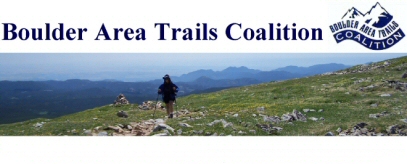

Homepage - Brochure - Application - Newsletters - Issues - Links - Weather - Board
BATCO's mission is to promote non-motorized, multi-use, environmentally responsible trail systems in Boulder County. We help preserve, create, and enhance environmentally responsible trails systems. We believe trails are valuable community resources that provide recreational and environmental benefits that enhance the quality-of-life of area residents and visitors.
In the context of the Visitor Master Plan (VMP), our interests are in multi-use trails, regional trail connections, and the quality of the user experience.
We believe the Goals and Objectives of the VMP are laudable. We are interested in developing harmony between Goals 1 & 2 (to paraphrase, maintaining and enhancing the quality of the visitor experience while ensuring resource preservation) and in participating in the community decision making and stewardship of Goal 3.
We've organized the following comments on the draft VMP into areas of agreement, disagreement, omissions and desirable extensions, concerns and comments, and specific recommendations.
Except for the specific new priority trails, the future vision for the trails system is missing. References to previous area management plan trails that are as yet unrealized are missing. Boulder Valley and County Comprehensive plan regional trail connections are missing. These specifics may not be subjects of this document, but note should be made that they exist and need to be addressed in subsequent management planning.
Specific area management plans need to be developed for the OS properties that lack previously developed management plans. The VMP should include a definition and time-line for these plans. The VMP recommendation to close new properties to the public until management plans are developed is acceptable only if there are schedules and processes for the timely creation of such plans.
A community process for dealing with undesignated trails needs to be included in the management planning process. Something similar to the present community group process might be appropriate. The VMP may not need to define all the details of the specific process, but the need for one must be noted.
Clear processes must be defined for making future access and trails decisions. We'd like to see the groups such as the Trails Committee and the Dog Roundtable reinstated as participants in the process.
We continue to believe the conditional analysis is overly pessimistic and are concerned that it may lead to unnecessary visitor restrictions. Invoking more restrictive visitor management strategies implies an obligation to (1) state the specific concerns, (2) determine by study that the concerns are justified, and (3) select the least impact approach to address the concerns. The invocation of the "precautionary principle" which underlies the proposed OSMP priority of preservation policy should require a clear statement of the nature of the concern including the species threatened, the OSMP areas involved, and the nature of the threat. (Without such information it's hard to see how the threat can effectively be addressed.) In addition, invocation of this principle should trigger an objective research effort designed to resolve as many uncertainties as possible and clarify the true nature and validity of the concern. Also triggered would be an open and public "call for proposals" which asks OSMP constituents to propose creative strategies for addressing the environmental concerns while also protecting OSMP's ability to pursue its visitor and other objectives.
To the extent that designation of the proposed "habitat conservation areas" implies invocation of this precautionary principal the above steps should also be triggered.
The off-trail permit system is problematic. There's a concern it could be viewed as a private access system for the self-selected elite. Specifics need to be defined to assure the application and granting of such permits is equitable for all visitors. A process similar to the Forest Service's back-county permit approach is required (first-come-first-served, all visitors and permitted activities welcome).
Alternate management strategies should be included (esp. in prairie HCA areas). In particular:
- Corridor voice-and-sight
- Seasonal limitations (area closures, on-trail restrictions, or leash regulations)
- Off-trail access in prairie HCA areas
Some specifics here would include:
- Corridor voice-and-sight trail accesses to Green Mountain and Bear Mountain and South Boulder Peak summits
- Seasonal leash regulations on some prairie trails (e.g., South Boulder Trail and Big Bluestem west of HW93).
More flexibility in HCA definitions and strategies:
- HCAs requiring trail infrastructure definitions:
- North Foothills (trail decision pending/on-hold based on past management plan)
- Jewel Mt., Eldorado Mt., Tallgrass Prairie East, Southern Grasslands, and Lower Boulder Creek all lack management plans and infrastructures. We need provisions that allow for new trails on these properties before the HCA restrictions on new trails should apply.
- BATCO supports the trail infrastructure identified on the BCHA Priority Trails map for these areas
- HCAs that should have provisions for some off-trail access (esp. for equestrians):
- North Foothills, Tallgrass Prairies East & West, Southern Grasslands, Eldorado Mt., and Jewel Mt.
A future vision for the trails system including:
- References to previous area management plan trails that are as yet unrealized are missing (Axelson and West Beech trails in particular).
- Boulder Valley and County Comprehensive plan regional trail connections are missing (e.g., the UPRR trail and connections south to JeffCo).
Additional designated mountain bike trails:
- West of HW36
- South Foothills Bicycle Trail (a suggested possible alignment)
- Mesa Trailhead to South Boulder Creek West Trailhead (via southern Mesa Trail and lower Big Bluestem Trails)
- Lower Big Bluestem to Shanahan Ridge
- Shanahan Ridge to Table Mesa Drive (via North Fork Shanahan & Mesa Trail to Bear Canyon Trail & NCAR east frontage road)
- NCAR east frontage road (Table Mesa Drive to Ithaca Drive)
- Walker Ranch Connection (via Ithaca Drive Trailhead, Bear Canyon Trail, & Bison Road)
- North Boulder bicycle loop trail designated using some of the Hidden Valley/Mesa Reservoir trails system components.